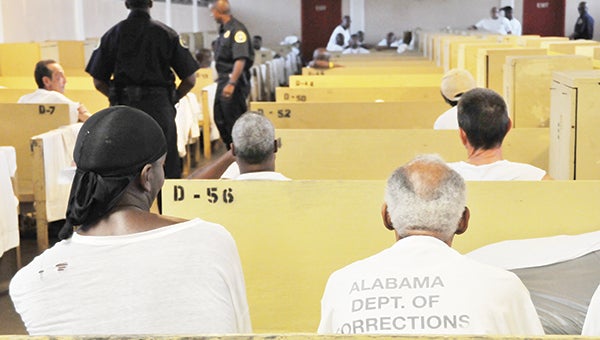HARD TIMES
Published 10:31 am Wednesday, September 2, 2015

Andrew Garner/The Atmore Advance
Shown are inmates in the general population at William C. Holman Correctional Facility.
Commissioner: We need to pass reform bill
By Andrew Garner
Editor
Funding the criminal justice reform bill is a vital piece of legislation that needs to be passed, Alabama Department of Corrections Commissioner Jeff Dunn said Monday.
Dunn held a short question-answer portion for the media after a tour was given in the William C. Holman Correctional Facility in Atmore.
Dunn said passing the bill will be a great start to help solve many problems within the DOC, including overcrowding, the lack of staff and facility improvements.
At present, the DOC operates 28 prisons — 16 major facilities and 12 work release/community work centers. The oldest prisons are Draper Correctional Facility (1939) in Elmore and the Julia Tutwiler Prison for Women (1942) in Wetumpka. The newest facility is the Bibb Correctional Facility, which was built in 1998.
Holman prison opened in December 1969.
For fiscal year 2015, $394.3 million was appropriated for the department of corrections. Approximately 3,900 employees work for the DOC, and the department houses 24,700 inmates.
Dunn said Senate Bill 67, or the Criminal Justice Reform bill, is a great first start for the state.
The bill would invest $26 million in fiscal year 2016 and more than $25 million annually for fiscal year 2017 through fiscal year 2021, according to the DOC.
Dunn said if passed, the bill will also increase supervision, increase substance treatment and recidivism reduction programs and add 123 parole officers, among others.
Recidivism is when an inmate relapses into his or her previous criminal behavior and gets put back in the prison system.
“Sixty percent of inmates come back,” Dunn said. “That just adds to the overcrowding problem.”
Prison populations in the state are more than what the capacity of the prisons are designed for. For example, in close custody, which is the most restrictive custody level, there are 7,900 inmates in a designed capacity of 5,103.
Including medium and minimum custody level, there is a 184.2 percent increase in the prison population over the design capacity.
Dunn said the overcrowding issue is as a result of a rise in the prison population during the 1980s and 1990s when the Tough on Crime laws were imposed.
“In 1988, the population began to sky rocket,” Dunn said.
According to the Alabama Department of Corrections, the top five convictions for inmates include drug possession, drug trafficking, theft, burglary and robbery.
Additionally, when fully implemented, the legislation is projected to reduce inmate population by 16 percent, or 4,500 inmates.
If there is a 5 percent cut in the general fund budget, it will create a $43 million deficit, which will close three prisons and increase the number of bunks for facilities.
Dunn said there would be a 213 percent increase in the prison population.
Dunn said if the prison budget remains level and if there is $15 million added, then it would run at status quo.
The risks of not passing the prison reform bill would impact many areas, including increasing recidivism and impacting public safety, increasing overcrowding, increases risk to correctional staff, admin and medical personnel, and increases costs, Dunn said.
Holman prison was designed for 637 inmates. The inmate population as of Monday was 996.
There are 165 death row inmates.
Eighty-seven assigned correctional officers are on staff at the facility.





